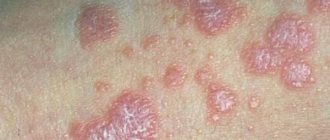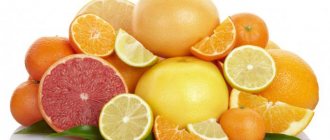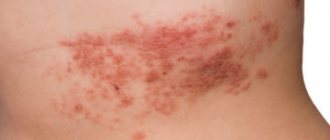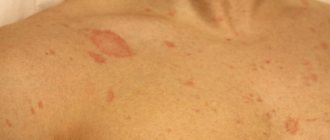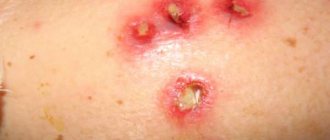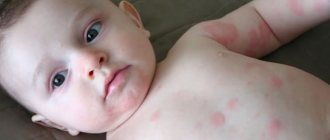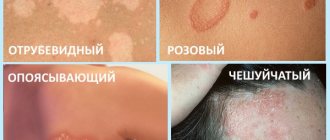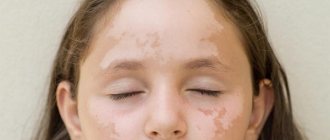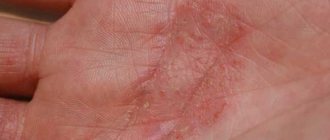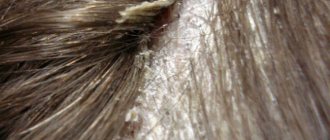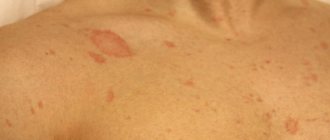The origin of itchy spots and blisters on the skin is associated with the growth of microscopic fungi in the epidermal cells and a viral infection. An effective anti-lichen ointment for children, recommended by a dermatologist, will help to quickly cure a fungal disease. First, the doctor will determine the type of infectious agent and its sensitivity to drugs.
How to treat lichen in a child
The fungus parasitizes in the epidermis, where the causative agent of the disease feeds on keratin. First, a small area of skin changes, then the size of the lesion increases. A fungal infection affects children with weakened immune systems.
Ringworm is easily recognized in a child by symptoms such as round pink-red spots, itching, flaking, and hair loss. Lesions occur on the head, limbs, and torso.
The appearance of flaky spots is considered the main symptom of lichen of fungal origin. At home, ointments for lichen for children from the pharmacy and folk remedies are used. After applying the antifungal agent for 5–6 days, the itching and size of the lesion decrease. The total duration of the course of therapy is 1–2 months.
Recipes and traditional medicine at home
There are many effective folk ways to combat lichen. Before using them, you should definitely consult with your doctor. Without an accurate diagnosis and permission from the pediatrician, self-medication is dangerous!
Products used to lubricate spots caused by lichen caused by a fungal infection:
- Propolis tincture for treating affected skin areas.
Pour 25 g of propolis with 100 ml of ethyl alcohol, place in a dark place to infuse for 7 days.
- A mixture of olive oil and citric acid.
For 3 parts oil, take 1 part crystalline acid.
- A mixture of baking soda and salt.
To prepare, you need to take the ingredients in equal proportions, dilute with water to obtain a thick paste.
- A mixture of Vaseline or vegetable oil with crushed calendula flowers in a ratio of 5:1.
- For pityriasis versicolor, it is recommended to use an infusion of seeds and crushed sorrel root.
A tablespoon of ingredients is poured into 200 ml of boiling water. An effective remedy can also be prepared from crushed leaves of this plant, mixing them with sour cream.
- Pharmacy tinctures of celandine or salicylic acid.
External remedies against lichen: pros and cons
Ointment is a dosage form of soft consistency, containing one or more substances. The differences with gels and creams lie in the characteristics of the base and the depth of penetration into the skin. Most pharmacy ointments contain medical petroleum jelly. Creams are produced on the basis of vegetable oils and lanolin. They are easier and more evenly distributed on the skin. Auxiliary components reduce inflammation and protect affected skin.
It doesn’t matter what to apply to a child’s lichen - ointment, cream or gel. Active substances penetrate into the uppermost layers of epidermal cells, where the mycelium of the fungus is located.
Combination drugs contain antibiotics, antifungal and hormonal substances. This composition has both advantages and disadvantages. The use of a combined anti-lichen ointment for children allows you to quickly get rid of the clinical manifestations of microbial infection and the inflammatory process. However, a more effective drug may have severe side effects. Hormonal components cause skin atrophy with prolonged use. Antibiotics have a negative effect on all microflora, including beneficial types of bacteria.
Levomekol
To quickly relieve inflammation, remove redness of the skin and alleviate severe itching, doctors prescribe an effective and inexpensive Levomekol ointment for lichen in humans. The medicinal product resembles a paste in its consistency and color; it is an independent treatment or part of a complex therapy. Its protective properties are an effective prevention when the symptoms of pityriasis rosea have completely disappeared. Here's what's important to know about this ointment:
- composition - the active component, being a tissue regenerator, is called dioxomethyl tetrahydropyrimidine;
- indications – purulent wounds, bedsores, herpes, purulent acne, trophic ulcers, various forms of hemorrhoids, infectious and inflammatory processes of the skin;
- method of application - the patient needs to lubricate the affected areas of the body with a thin layer until completely absorbed, the duration of intensive therapy is up to 10 days;
- contraindications – fungal skin infections, psoriasis, eczema, increased sensitivity of the body to active substances; the occurrence of side effects is possible.
The cheapest ointments to get rid of skin fungus in children
Ringworm, white and pityriasis versicolor in children are treated with external agents with antifungal active ingredients. Stains on the skin of mycotic origin should be treated with antiseptics. Iodine tincture 5%, chlorhexidine, salicylic alcohol are suitable. Apply the solution only to the site of infection once or twice a day. Ringworm in young children is treated with iodine tincture 3%, and a few peas of baby cream are added to the medicinal ointment.
How to anoint a child’s ringworm:
- Riodoxol ointment is an inexpensive and effective remedy recommended for the treatment of dermatomycosis in children. The drug was produced and tested in Russia. The active ingredient is triiodoresorcinol.
- Sulfur ointment is an affordable drug for the treatment of skin diseases of infectious and non-infectious origin.
- Sulfur-salicylic ointment has antimicrobial properties, has an anti-inflammatory effect and promotes proper exfoliation.
- “Yam” ointment contains tar, carbolic acid, sulfur, ichthyol, turpentine and other components to get rid of skin parasites in domestic animals and humans.
Sulfur interacts with organic compounds in the cells of the epidermis; the reaction products have antiparasitic and antimicrobial properties. Sulfur ointment helps cleanse the skin of dead cells. The basis of the drug - an emulsion of Vaseline with water - softens and protects the epidermis, accelerates healing.
Sulfur ointment is used for the treatment of lichen in a child for 5–7 days. Apply a thin layer of the product in the morning and evening, and apply a bandage on top.
The combination of sulfur and tar has a detrimental effect on microbial infection. The product works powerfully, but causes a lot of problems. The sharp smell of tar is immediately felt and persists for a long time. Possible irritation to the mucous membranes of the eyes and upper respiratory tract. A child is unlikely to agree to have an unpleasant-smelling product applied to his skin.
The combination of sulfur, carbolic acid, ichthyol, tar, turpentine and other ingredients in the Yam ointment has a detrimental effect on skin parasites. The product for external use has an unpleasant odor and color. The components can cause a severe allergic reaction and skin burns.
Ringworm: what is it?
The medical term “lichen” covers a number of diseases that differ in nature, signs of manifestation and treatment methods. The similarity is observed in the characteristic spots on the epidermis. The choice of medication is determined strictly by a dermatologist after accurately determining the type of dermatosis.
Lichen is divided into several types:
- viral (shingles) or herpes virus, which remains in the body after chickenpox. Activation and reproduction occur when the immune system is weakened;
- fungal (ringworm, pityriasis);
- unknown – pink and red lichen planus. They are rare species that have not been fully studied;
- others are psoriasis (scaly) or eczema (weeping).
Before prescribing treatment, the doctor must conduct a complete examination of the child to identify the causes of the pathology. Ointments and tablets are selected individually, and we will look into what is the best way to treat lichen in children in each case.
Groups of tablet drugs for lichen on the human body
Effective tablets for lichen on the human body
If the disease occurs in a mild form without complications, then treatment is limited to means in the form of gels, ointments, and sprays. In severe cases, a course of tablets is prescribed. In many cases, lichen is treated with antifungals, antihistamines, antivirals, and antibiotics.
Antifungal
Antimycotic drugs are divided into groups, differing in action and clinical use for various fungal infections:
| Classification | Drugs |
| Means for the treatment of dermatomycosis |
|
| Means for the treatment of candidiasis |
|
| Agents for the treatment of systemic mycoses |
|
Antiviral
Antiviral drugs for lichen are prescribed for the treatment of herpes zoster and rosea types. If you start taking such medications no later than 3 days from the onset of the disease, the lichen will disappear without any consequences.
Antibiotics
Antibiotics do not treat lichen; they are prescribed for severe forms of the disease, when ulcers appear with the addition of infection. Antibiotics reduce the activity of bacteria, relieve inflammation and prevent the formation of suppuration. The course of therapy in this case should not exceed 14 days.
Anti-inflammatory
Among anti-inflammatory drugs, glucocorticosteroids are the most active. These are hormonal agents that increase the body's resistance to stress and affect metabolism. Anti-inflammatory medications are used for psoriasis, eczema, and lichen ruber.
To boost immunity
Immunomodulatory agents stimulate the body's protective functions and effectively resist viruses. Such drugs are prescribed as auxiliary agents that destroy the proliferation of infection. It is best to use natural remedies from this group, as they are better suited than others and will not cause complications in the body.
Vitamins and microelements
Vitamin A and retinol are used in the treatment of lichen and psoriasis, as they have the ability to stop the development of diseased cells. Vitamin C and ascorbic acid remove toxins from the body and reduce sensitivity to allergens. The doctor prescribes vitamins B1, A, C, B6 without fail when lichen appears.
Pink type (Gibera)
The disease is classified as an infectious form, although experts do not have a complete consensus on the nature of its etiology. It most often affects girls aged 4 to 12 years. After suffering from the disease, persistent lifelong immunity is developed, and it is no longer possible to become infected with it again.
The first symptoms of the disease, as a rule, are slight malaise and slightly elevated body temperature. However, round red spots, characteristic of the Zhiber form, can appear on the body without such a “warning”. At the beginning of the disease, the so-called oval-shaped maternal plaque is small in size (no more than 1-2 cm). Its surface remains smooth for two or three days, but then begins to peel off and takes on the appearance characteristic of lichen.
Following this, a rash appears, sometimes covering the entire surface of the body, but most often localized on the chest, abdomen and shoulders.
As a rule, Zhiber's lichen in children goes away on its own, without the need for special treatment. But consultation with a dermatologist is necessary, since its symptoms are similar to more serious diseases such as eczema, and only a specialist can make an accurate diagnosis. Then the doctor prescribes medications to the child aimed at relieving itching, strengthening the immune system and eliminating allergic reactions.
The treatment regimen includes:
- Use of medications (Ascorutin, Fenistil) in a dosage approved by the attending physician.
- A diet that excludes the consumption of honey, chocolate, citrus fruits, eggs and other foods that can cause an allergic reaction.
- Limiting skin exposure to sunlight.
- Minimizing hygiene procedures related to water and completely eliminating the use of washcloths and detergents.
- Exclusion from the wardrobe of clothes made from wool and synthetic fabrics that irritate the skin.
